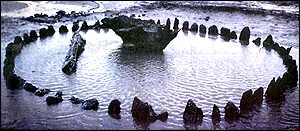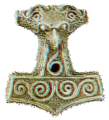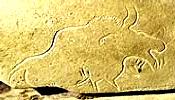
|
|
|
New
Nation News - European Pre-History News
|

|
|
| "For there is hope of a tree, if it be cut down, that it will sprout again," |
| Kennewick Man | Western Civilization | news links | March 6, 2013 |
|
(note: some older links may
have expired - ed.)
|
|
European Pre-history
News
|
|
|
|
|
|
|
|
 Thor's
Hammer Thor's
Hammer Miniature Thor's hammers were widely used as religious amulets during the Viking era. These charms were normally between two and three centimeters in length, and typically made from silver. The following examples are typical of the approximately fifty such amulets that have been discovered. THOR the Viking Thunder God |
|
|
|
|
|
|
|
|
|
|
Cussac
Cave art may be oldest found in France. Engravings could predate Lascaux
paintings  PERIGUEUX, France (AP) -- Vivid prehistoric engravings that could date back as far as 28,000 B.C. have been found in a cave in western France, regional officials said July 4th, 2001. An archaeologist characterized the engravings as a major discovery. They are believed to predate the world's oldest cave paintings -- the 18,000-year-old paintings in the famed Lascaux caves, also in western France. |
|
|
|
|
|
|
|
|
|
|
|
|
|
|
|
|
|
|
Helge's saga |
|
|
|
Texas A&M Field School Discoveries May Rewrite History Of Early North American Man New discoveries in a valley on the eastern edge of the Texas Hill Country will prompt rewriting the history of early North American man, predict Texas A&M University archaeologists who are co-directing excavations at the artifact-rich site. |
|
|
|
 New
'Seahenge' - Archaeologists are examining a mysterious circle of wood New
'Seahenge' - Archaeologists are examining a mysterious circle of woodwhich has emerged from under the shifting sands on the coast of Norfolk in the UK. The structure was discovered just 100 metres from the site where the famous Bronze Age monument known as Seahenge was uncovered more than two years ago. The new circle is slightly bigger than Seahenge. |
'Seahenge'
will be reburied under the Norfolk sands The
Bronze Age timber circle known as "Seahenge" will be reburied under the
Norfolk beach from which it was excavated for scientific research more
than a year ago. The
Bronze Age timber circle known as "Seahenge" will be reburied under the
Norfolk beach from which it was excavated for scientific research more
than a year ago. Druids and modern-day pagans had organised sit-ins against English Heritage's decision to remove and preserve the wood. |
|
|
Dig uncovers "Boudicca's brutal streak" In the history books, she is a flame-haired paragon of wronged womanhood, a first-century feminist leading a horde of righteous Britons against their nasty Mediterranean overlords. A dig in Colchester has revealed that, when Boudicca's troops seized the city in the first year of their two-year revolt that began in AD60, they went to enormous lengths to destroy anything touched by the Romans... Estimates of the number of Romans and 'collaborators' killed by Boudicca and her followers vary, although Roman historians claimed that up to 70,000 people died... For 150 years the woman who led the Iceni tribe from its base in Norfolk against the Roman invaders has been viewed as an icon of national resistance. |
Rare Skeleton Has Scientists Nervous* Rare Genetic Link to Europe |
Mysterious 4700 Year Old Temple Site Found In Wales |
Scholars push idea of early European settlement of America (reader) (extract) |
|
|
|
| Anthropology
in the News - Breaking News The Ancient World - Breaking News Archaeology Magazine |
| since 8/22/98 | web site map |